Cheadle Hulme railway station
Cheadle Hulme railway station is a station in Cheadle Hulme, Greater Manchester, England. It is operated by Northern Trains.
Cheadle Hulme | |
|---|---|
.jpg.webp) Platforms 1 and 2, with the footbridge, constructed in 2011, clearly visible in the background. | |
| General information | |
| Location | Cheadle Hulme, Metropolitan Borough of Stockport England |
| Grid reference | SJ875865 |
| Managed by | Northern Trains |
| Transit authority | TfGM |
| Platforms | 4 |
| Other information | |
| Station code | CHU |
| Classification | DfT category D |
| Passengers | |
| 2017/18 | |
| 2018/19 | |
| 2019/20 | |
| 2020/21 | |
| Interchange | 1,530 |
| 2021/22 | |
| Interchange | |
| Location | |
| Notes | |
Passenger statistics from the Office of Rail and Road | |
Cheadle Hulme's first railway station opened in 1842, when the Manchester and Birmingham Railway to Crewe was completed. With the extension of the line to Macclesfield, and later Stoke-on-Trent, a new station opened in 1845 which has served the area since.
History
Background
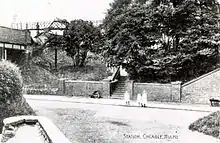
In 1833 Parliament approved the Grand Junction Railway, a railway line to connect Manchester and Birmingham.[1] It opened in 1837, after proposals had been made for more direct routes in 1830 and 1835. The earlier schemes attracted little interest, but two proposals were put forward in late 1835. The two companies, based in Manchester and Birmingham, had to negotiate with each other to develop the proposals, and they were altered somewhat over the next two years. In 1837 Parliament approved the final plans for lines to Crewe and Stoke. The companies merged to become the Manchester and Birmingham Railway company, and the first part of the line opened in June 1840. It originally ran from a temporary station at Travis Street in Manchester, to a station in Heaton Norris just north of Stockport.[2] A large viaduct was built over the River Mersey, and opened to trains on 10 May 1842. It allowed services to be extended to Sandbach; in the following August they reached Crewe. Also at this time, a new station opened to serve as the line's northern terminus; it later became Manchester Piccadilly. Edgeley railway station opened in February 1843 in response to complaints that the Heaton Norris station was "too inconvenient", and it soon became Stockport's busiest station.[3] Three years later in 1846 the Manchester and Birmingham Railway company merged with two other companies to become the London and North Western Railway.
Cheadle station
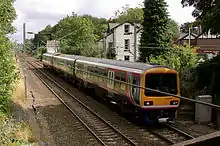
The original Cheadle Hulme railway station on the Crewe line, about 0.3 miles (0.5 km) south-west of the current structure, was known simply as "Cheadle". It was in use from May 1842, following the opening of the viaduct. The station building, opposite the Hesketh Tavern public house, is now a private residence. It included a structure from which tickets were sold, and in the window of which a candle was lit to act as a signal during the hours of darkness.[4] This structure, however, no longer exists.[5]
When plans were made for a line to Stoke-on-Trent, it was originally intended for a branch to be built from Stockport to Macclesfield. Instead, the junction was built south at Cheadle Hulme. The line was constructed over four years: it opened for goods traffic as far as Poynton in June 1845, and on 24 November it reached Macclesfield and was opened to the public.[6] In June 1846 Parliament authorised the completion of the line to Stoke-on-Trent.[7] By June 1849 the section between Congleton and Macclesfield was completed and the line was finished.[8]
New station
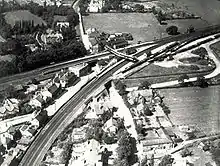
After the Stoke line opened, the station was rebuilt north-east at the junction so it could serve both lines. The new station opened on 9 June 1845; at first, southbound services ran to Crewe and Poynton. By November the line had been extended to Macclesfield, and by 1849, when the original station closed, it had reached Stoke-on-Trent. The new station had four platforms, and was served by trains running between Manchester and Crewe or Stoke-on-Trent.[9] It was renamed Cheadle Hulme in 1866, to avoid confusion with Cheadle LNW railway station which opened the same year.[10]
Before the arrival of the railway, Cheadle Hulme was a rural and agricultural cluster of hamlets. The railway brought a huge influx of people to the area, and provided opportunities for residents to work in places such as Manchester. Cheadle Hulme gradually grew to become a large suburb of over 29,000 people thanks to the railway.[4]
Derailments
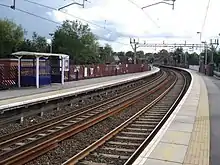
A special train - known as the "Lollipop Express" - carrying 234 school children from Gnosall, Stafford to York for a day trip derailed at the station on 28 May 1964.[11] Three people, including two children, were killed and 27 were injured. The bridge, which carried the line between Macclesfield and Stoke, was in the process of being reconstructed. Passing trains were restricted to a temporary speed limit of 10 mph (16 km/h).[12] A hearing determined that the train's excessive speed had caused the derailment because the train driver was not aware of the speed restriction.[12][13]
In July 1969, there was another derailment near Cheadle Hulme involving a freight diesel locomotive. It injured no one but blocked services to Crewe and Stoke-on-Trent for several hours.[14]
Alterations
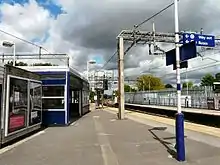
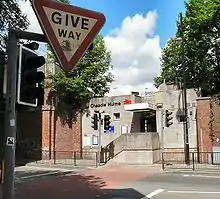
The original station was sited above road level (as it is today). Passengers accessed the other two platforms by a footbridge, which was removed after the lines were electrified.[5] Cheadle Hulme was also used as a goods depot until 31 October 1964, when goods trains were withdrawn.[15] The goods yard is now a car park.[5]
The lines to Crewe and Stoke-on-Trent were electrified in 1960 and 1967 respectively.[10] In 1963, due to the growing amount of traffic travelling down Station Road, it was decided that the parts of the road that pass under the bridges should be widened, as they were becoming a bottleneck. The bridge carrying the line to Stoke was upgraded first. The road under it was more than doubled in width, and the bridge height was increased by 3 feet (0.9 m) allowing double-decker buses to pass underneath.[16]
Work on the second bridge commenced on 8 June 1965, increasing the height and width in accordance with Ministry of Transport requirements. Around this time, the station itself was upgraded: the platforms were demolished and replaced, and new waiting shelters were erected. A new booking office, facing Station Road and approached by a flight of stairs, was built alongside a new booking lobby, toilets and staff accommodation. New entrances to the platforms were built, and the entire station was installed with electric lighting.[17] Station Road was significantly widened and rerouted slightly in 1967 in a further attempt to accommodate increasing traffic.[18]
As part of the privatisation of British Rail, all stations in the United Kingdom were sold to Railtrack, and each would be managed by a franchised train operating company. In Cheadle Hulme's case, this was First North Western. In 1996, Railtrack launched a £1 billion programme to restore and renovate every station it operated. Cheadle Hulme had £1.2 million spent on repairs to its platforms, buildings and waiting shelters, and new lighting installed throughout the station. Stephen Day, the Member of Parliament (MP) for Cheadle Hulme, opened the updated station in March 1998.[19]
The junction itself was revamped in 2000 and the signal box was removed, having been superseded by a central signalling point at Stockport station.[10]
In 2002, Railtrack entered administration and ownership of the station transferred to the newly formed government-owned company Network Rail, but it was still managed by First North Western. In 2004, management of the station transferred to Northern Rail, and in 2011, major work was carried out after years of campaigns, with the construction of pedestrian bridges connecting all four platforms, and lifts enabling disabled access to the platforms. PA equipment was also installed, but not brought into use until later.
In April 2016, management of the station transferred to Arriva Rail North (ARN). At the end of February 2020, ARN's franchise was transferred to an operator of last resort known as Northern Trains due to ARN's poor performance. Under ARN and Northern Trains, several improvements were made to the station, including refurbishment of the waiting rooms; replacement of the station lighting, customer information screens and ticket machines; and installation of an Amazon Locker.[20] In addition, the PA equipment installed in 2011 was finally brought into use to provide automated announcements across the station.
Modern-day station layout
The station is immediately south of a V-shaped junction station on the West Coast Main Line, where the lines to Crewe and Stoke-on-Trent split. It is above street level. There are four platforms:
- Platforms 1, accessed from a long flight of stairs from Station Road, serves trains towards Manchester from the direction of Alderley Edge and Crewe.
- Platform 2, accessed through the ticket office, serves trains towards Alderley Edge and Crewe.
- Platform 3, also accessed through the ticket office, serves trains towards Manchester from Stoke-on-Trent
- Platform 4, accessed either from the car-park to the east of the station, or via another long flight of stairs, serves trains towards Stoke-on-Trent.
Each platform is provided with waiting shelters, passenger information screens, and lifts and stairs to footbridges enabling access between platforms, which were constructed in 2011. There is also a lift to the car park, enabling disabled access to the station. An Amazon Locker is located between platforms 2 and 3.
Services
Northern Trains provides passenger services. Three trains per hour run northeastwards to Manchester Piccadilly, one of which extends north of Manchester Piccadilly to Southport via Bolton. In the other direction, trains run hourly on the Stoke-on-Trent line (serving all stations to Kidsgrove, then Stoke-on-Trent). On the Crewe line, one train per hour runs to Alderley Edge serving all stations, and one train per hour serves the same stations and continues to Crewe.[21]
| Preceding station | Following station | |||
|---|---|---|---|---|
| Northern Trains | ||||
| Northern Trains |
Sundays sees an hourly Crewe to Manchester Piccadilly service each way and six trains to and from Stoke-on-Trent.
References
- Crouzet, p.284
- "A more direct way to Manchester" (PDF). Virgin Trains. Archived from the original (PDF) on 16 October 2006. Retrieved 25 May 2009.
- Arrowsmith 1997, p. 168
- Squire 1976, p. 5
- Garratt 1999, p. 27
- Knight, p.677
- Slaughter, p.25
- Ingham, p.364
- Reid & Lee 1979, p. 40
- Shannon & Hillmer 2003, p. 77
- "The Lollipop Express train crash remembered 50 years on". BBC News. 28 May 2014.
- "Report on the Derailment that occurred on 28th May 1964 at Cheadle Hulme Station" (PDF). Ministry of Transport. The Railways Archive. 30 November 1964. Retrieved 26 May 2009.
- Semmens, Peter; Marsden, Colin J. (July 1995). Pigott, Nick (ed.). "School train crashes - three die". The Railway Magazine. IPC Media. p. ix.
- "Train is derailed". Stockport Express. Guardian Media Group. 17 July 1969.
- "B.R. refuse council request". Stockport County Express. Guardian Media Group. 25 October 1964.
- "The Cheadle Hulme rail disaster". Stockport Advertiser. Guardian Media Group. 4 June 1964.
- "Early start on railway station transformation". Stockport Advertiser. Guardian Media Group. 27 May 1965.
- Lee 1967, p. 4
- "Platform for the future". Stockport District Advertiser. Guardian Media Group. 6 March 1998.
- "A better way to go: Improving every step of your journey". Northern Railway. Archived from the original on 8 December 2020.
- Table 84 National Rail timetable, December 2019
Bibliography
- Arrowsmith, Peter (1997). Stockport: A History. SMBC. ISBN 0-905164-99-7.
- Crouzet, François (1982). The Victorian economy. Routledge. ISBN 0-416-31110-5.
- Garratt, Morris (1999). Pictures and Postcards from the Past: Cheadle Hulme. Sigma Leisure. ISBN 1-85058-674-8.
- Ingham, Alfred (2003). Cheshire: Its Traditions and History. Kessinger Publishing. ISBN 0-7661-5506-4.
- Knight, Charles (1851). Penny cyclopaedia of the Society for the diffusion of useful knowledge. Society for the Diffusion of Useful Knowledge.
- Lee, Ben (December 1967). A History of Cheadle Hulme and its Methodism. Trustees, Cheadle Hulme Methodist Church.
- Reid, T. D. W.; Lee, Irene (1979). Cheadle in 1851. Stockport Libraries. ISBN 0-905164-00-8.
- Shannon, Paul; Hillmer, John (2003). British Railways Past and Present No 40 Cheshire. Past and Present Publishing Ltd. ISBN 1-85895-232-8.
- Slaughter, Mihill (1849). Railway intelligence. W.H.Smith & Son.
- Squire, Carol (January 1976). Cheadle Hulme: A Brief History. Recreation and Culture Division, Metropolitan Borough of Stockport.
Further reading
External links
- Train times and station information for Cheadle Hulme railway station from National Rail
- Crewe-Manchester Community Rail Partnership